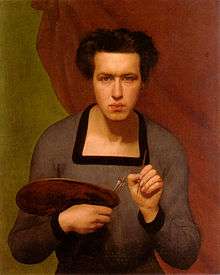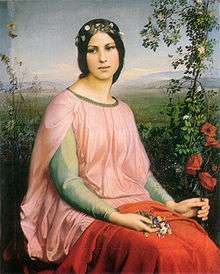Louis Janmot
| Anne-François-Louis Janmot | |
|---|---|
 Louis Janmot (self-portrait, 1832) | |
| Born |
21 May 1814 Lyon, France |
| Died |
1 June 1892 (aged 78) Lyon, France |
| Nationality | French |
| Education |
Royal College of Lyon École des Beaux-Arts de Lyon |
| Spouse(s) |
Leonie Saint-Paulet (1855-1870) Antoinette Currat (1885-1892) |
Anne-François-Louis Janmot (21 May 1814 – 1 June 1892) was a French painter and poet.
Early years
Janmot was born in Lyon, France of Catholic parents who were deeply religious. He was extremely moved by the death of his brother in 1823 and his sisters in 1829. He became a student at the Royal College of Lyon where he met Frederic Ozanam and other followers of his philosophy professor, Abbe Noirot. In 1831 he was admitted to the École des Beaux-Arts de Lyon and a year later, he won the highest honor, the Golden Laurel. In 1833, he came to Paris to take painting lessons from Victor Orsel and Jean-Auguste-Dominique Ingres. With other Lyon painters, he entered the Society of St. Vincent de Paul. In 1835, he went to Rome with Claudius Lavergne, Jean-Baptiste Frenet and other students and met Hippolyte Flandrin.
After his return to Lyon in 1836, Janmot would attract the attention of critics of the Salon de Paris in conducting large-scale paintings with religious inspiration such as The Resurrection of the son of the widow of Nain (1839) or Christ in Gethsemane (1840). After 1845, he attracted the interest of Charles Baudelaire with his painting Flower of the Fields that allowed him to access to the Salon of 1846. Theophile Gautier was impressed by his Portrait of Lacordaire (1846). But the failure of his Poem of the Soul at the Universal Exhibition of 1855 disappointed him. In December of that year he married Leonie Saint-Paulet, from a noble family in Carpentras.
In 1856, Janmot obtained a commission to paint a fresco (since destroyed) representing the Last Supper for the church of St. Polycarp. Other orders followed, including the decoration of the dome of the Church of St. Francis de Sales and for the town hall that had been renovated by his friend the architect T. Desjardins. He was then appointed professor at the École des Beaux-Arts.
In Paris and Toulon
Surprisingly, Janmot moved to Paris in 1861 after having been promised a commission for the Church of St. Augustine, but this project was abandoned three years later. In experiencing significant family and financial problems, Janmot accepted a professorship at the Dominican School of Arcueil. At that time, in his home in Bagneux, he made many portraits of the members of his family (only photographs are currently available).
After the birth of her seventh child in August 1870, his wife died in Bagneux. While the Prussian troops approached and occupied his home, he fled to Algiers with his stepfather and made landscape paintings. He returned in June of the following year in Paris and led a solitary life. His house in Bagneux had been looted. In 1878, he produced a fresco in the chapel of the Franciscans in the Holy Land, but this work was followed by any further order.
Faced with family and increasing financial problems, Janmot came to Toulon, and despite some orders (new Portrait of Lacordaire (1878, Museum of Versailles), Rosaire (Saint-Germain-en-Laye, 1880), Martyrdom of St. Christine (Solliès-Pont, 1882), he lived a retired life. He finished the second part of the Poem of the Soul that the patron and former industrial Félix Thiollier was willing to publish.
In 1885, Janmot married a former student, Antoinette Currat, and returned to Lyon. He made charcoal drawings on the theme of the underworld, which can be regarded as a kind of continuation of the Poem of the Soul, including Purgatory (1885) and The End of Time (1888). In 1887 was published in Lyon and Paris an over 500-page book entitled Opinion of an artist on art and includes articles previously written by Janmot. He died five years later at the age of 78.
Art style

Janmot has been seen as a transitional figure between Romanticism and Symbolism, prefiguring the French part of the Pre-Raphaelite Brotherhood; his work was admired by Puvis de Chavannes, Odilon Redon, and Maurice Denis.[1]
Like Jean-Hippolyte Flandrin, another painter from Lyon and student of Ingres, Janmot carried out many commissions for church decorations. In his paintings the immaculate finish of Ingres was combined with a mysticism that has parallels in the work of his contemporaries the Nazarenes and the Pre-Raphaelites.[1]
Works
| Wikimedia Commons has media related to Louis Janmot. |
Poem of the Soul
His most significant work, a cycle of 18 paintings and 16 drawings, with verse, called Poem of the Soul, occupied him for 40 years.
First part : the paintings Second part : the drawings 1. Génération divine 19. Solitude 2. Le Passage des âmes 20. L’Infini 3. L’Ange et la mère 21. Rêve de feu 4. Le Printemps 22. Amour 5. Souvenir du ciel 23. Adieu 6. Le Toit paternel 24. Le Doute 7. Le Mauvais Sentier 25. L’Esprit du Mal 8. Cauchemar 26. L’Orgie 9. Le Grain de blé 27. Sans Dieu 10. Première Communion 28. Le Fantôme 11. Virginitas 29. Chute fatale 12. L’Échelle d’or 30. Le Supplice de Mézence 13. Rayons de soleil 31. Les Générations du Mal 14. Sur la Montagne 32. Intercession maternelle 15. Un Soir 33. La Délivrance, ou vision de l’avenir 16. Le Vol de l’âme 34. Sursum Corda 17. L’Idéal 18. Réalité
 1. Génération divine
1. Génération divine 2. Le Passage des âmes
2. Le Passage des âmes 3. L’Ange et la mère
3. L’Ange et la mère 4. Le Printemps
4. Le Printemps 5. Souvenir du ciel
5. Souvenir du ciel 6. Le Toit paternel
6. Le Toit paternel 7. Le Mauvais Sentier
7. Le Mauvais Sentier 8. Cauchemar
8. Cauchemar 9. Le Grain de blé
9. Le Grain de blé 10. Première Communion
10. Première Communion 11. Virginitas
11. Virginitas 12. L’Échelle d’or
12. L’Échelle d’or 13. Rayons de soleil
13. Rayons de soleil 14. Sur la Montagne
14. Sur la Montagne 15. Un Soir
15. Un Soir 16. Le Vol de l’âme
16. Le Vol de l’âme 17. L’Idéal
17. L’Idéal 18. Réalité
18. Réalité
Other works

- Self-portrait (1832), musée des beaux-arts de Lyon
- Le Christ au Jardin des Oliviers (1840), musée des beaux-arts de Lyon
- Flower of the Fields (1845), musée des beaux-arts de Lyon
- L'assomption de la vierge (1845), musée d'art moderne de Saint-Étienne
- Henri Lacordaire, musée national du château de Versailles et de Trianon
Bibliography
- Élisabeth Hardouin-Fugier, Le Poème de l'âme par Louis Janmot, La Taillanderie, Châtillon-sur-Chalaronne, 2007, (ISBN 978-2-87629-358-8)
- Wolfgang Drost, Élisabeth Hardouin-Fugier, Louis Janmot, précurseur du symbolisme, C. Winter, Heidelberg 1994, (ISBN 3-8253-0209-1)
- Élisabeth Hardouin-Fugier, Louis Janmot, 1814–1892, Presses universitaires de Lyon, Lyon 1981, (ISBN 2-7297-0106-0)
- Louis Janmot, Opinion d’un artiste sur l’art, Vitte & Perrussel, Lyon 1887
- Jane Turner, From Monet to Cézanne: late 19th-century French artists? Grove Art, New York, St Martin's Press, (2000) (ISBN 0-312-22971-2)
- Sylvie Ramond, Gérard Bruyère et Léna Widerkher, Le Temps de la peinture, Lyon 1800-1914, Fage editions, Lyon (2007) 335 p. (ISBN 978-2-84975-101-5)
Notes
References
- Turner, J. (2000). From Monet to Cézanne: late 19th-century French artists. Grove Art. New York: St Martin's Press. ISBN 0-312-22971-2
External links
- Le Poème de l’âme – L'idéal
- Musée des Beaux-Arts de Lyon
- Charcoal sketches online at ArtRenewal Center Museum
- The Poem of the Soul - description of themes of the work
- Rouf, Gabriella (2012). "L'opera di una vita. Louis Janmot e Il poema dell'anima." (PDF). Il Covile. Retrieved 22 February 2013.